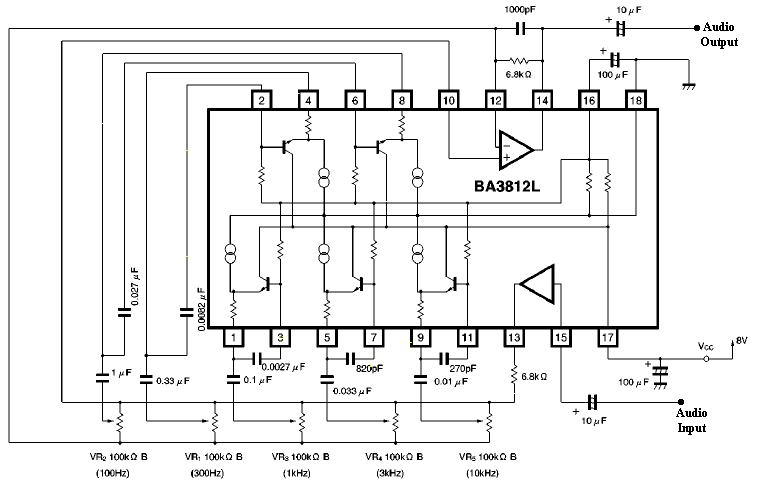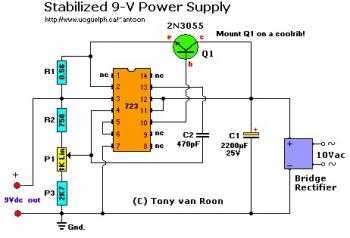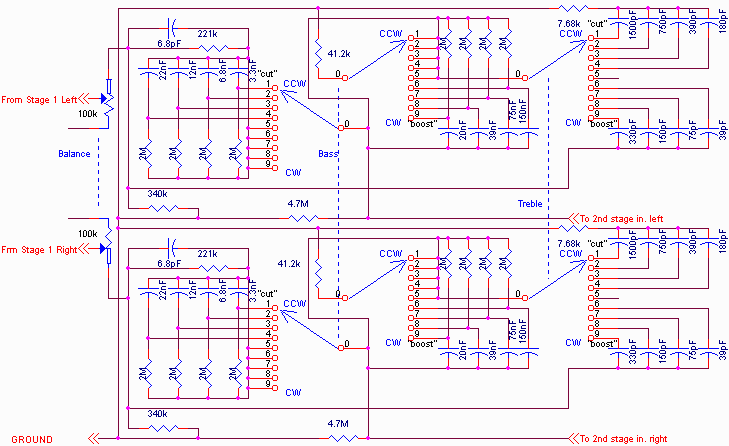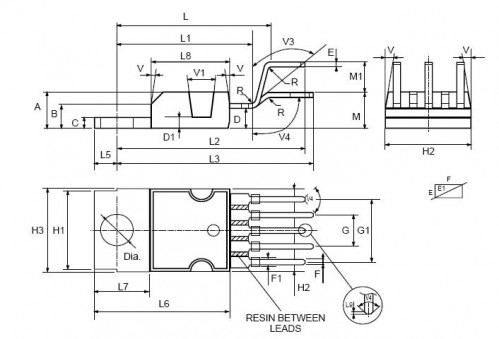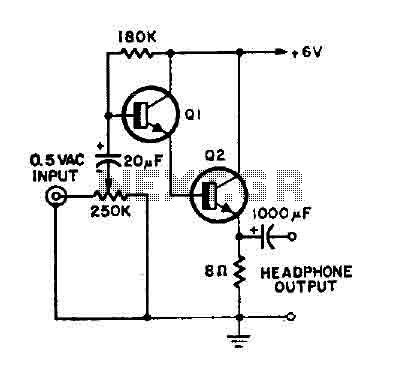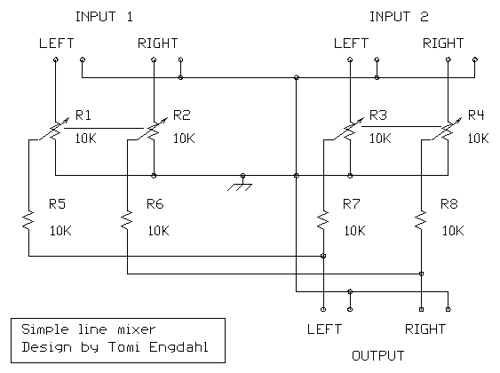
7W Audio Power Amplifier LF356
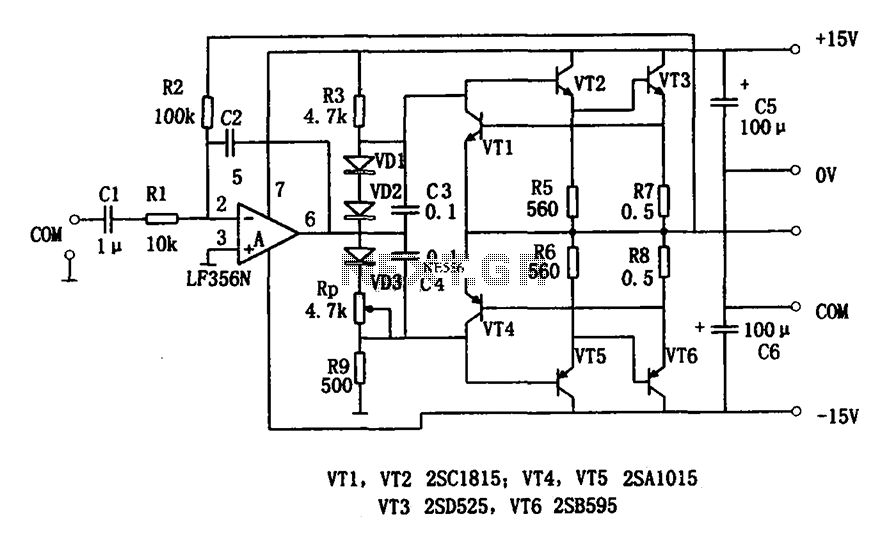
The circuit depicted is a low-frequency output 7W power amplifier. It employs a FET input operational amplifier, the LF356, for voltage amplification. The design features a transistor amplifier circuit that includes a driver stage. A significant negative feedback loop is incorporated, with feedback resistor R2 set at 100k ohms, and the input section consists of capacitor C1 (1µF) and resistor R1 (10k ohms) forming the coupling circuit. The AC component of the input signal is fed into the inverting input of the op-amp (pin 2), and the voltage gain of the circuit is calculated as Av = -R2/R1 = -100/10 = -10. The amplifier stage utilizes a complementary symmetry configuration with transistors arranged in a composite arrangement. Transistors VT1 and VT2 can be 2SC1815, while VT4 and VT5 can be 2SA105. Transistor VT3 is chosen as 2SD525, and VT6 is a 2SB595. The amplifier includes an overcurrent protection circuit; if the output current of transistor VT3 (or VT6) becomes excessive, the voltage drop across emitter resistor R7 (or R8) will increase, resulting in a positive voltage applied to the base-emitter junction of VT1 (or VT4). This positive bias causes VT1 (or VT4) to conduct, which, in turn, reduces the base current to VT2 (or VT5), thereby limiting the output current of VT3 (or VT6) to prevent damage from excessive current. Due to the high power ratings of VT3 and VT6, heat sinks are necessary for thermal management.
The low-frequency output 7W power amplifier circuit is designed for efficient amplification with a focus on stability and protection. The LF356 operational amplifier serves as the core voltage amplification component, leveraging its FET input characteristics to ensure low noise and high input impedance. The use of a negative feedback loop mitigates distortion and enhances linearity, crucial for audio applications.
The coupling circuit formed by C1 and R1 allows for the AC signal to be properly conditioned before reaching the op-amp. The calculated voltage gain of -10 indicates that the output signal will be inverted and amplified tenfold, suitable for driving subsequent stages or loads.
The complementary symmetry arrangement of the output transistors allows for efficient push-pull operation, which is essential in minimizing crossover distortion often found in traditional Class AB amplifiers. The choice of transistors, such as the 2SC1815 and 2SA105, provides a balance between performance and thermal characteristics, ensuring reliable operation under various load conditions.
The overcurrent protection mechanism is a critical feature of this design, preventing potential damage to the output transistors during fault conditions. By monitoring the voltage drop across the emitter resistors, the circuit can effectively limit the output current, thereby protecting the transistors from thermal runaway and ensuring longevity.
Overall, this low-frequency power amplifier circuit exemplifies a robust design approach, integrating feedback, transistor selection, and protective features to deliver reliable performance in audio amplification applications. The inclusion of heat sinks for the output transistors further emphasizes the necessity for thermal management in high-power electronic circuits, ensuring continued operation without failure. As shown for the low-frequency output 7W power amplifier circuit. The circuit uses a FET input type operational amplifier LF356 integrated as a voltage amplification. The class as a transistor amplifier circuit composed of the driver stage. Illustrated circuit has adopted a large negative feedback loop, which feedback resistor R2 is 100k, input terminus C1 (1 F) and R1 (10k ) constituting the coupling circuit. The AC component of the input signal is applied to the op amps inverting input (pin 2), the voltage can be seen, the circuit magnification: Av -R2/R1 -100/10 -10.
Stage amplifier circuit composed of complementary symmetry circuit by the transistor, the transistor connected to form a composite tube, transistor VT1 and VT2 can be 2SC1815, VT5 and VT4 can be used 2SA105, VT3 selection 2SD525, VT6 use 2SB595, after the amp has an overcurrent protection circuit If amplifier tube VT3 (or VT6) output current is too large, then the emitter 0.5 resistor R7 (or R8) will have a greater voltage drop, its polarity is positive on the negative. The voltage applied to VT1 (or VT4) between the base and emitter, so VT1 (or VT4) positively biased conduction (when the external load short-circuit, the saturated conduction), VT1 to VT2 conduction from diversion effect, make VT2 (or VT5) base current decline, thus limiting the VT3 (or VT6) of output current to prevent it from being damaged due to excessive current.
Due to the large VT3 and VT6 power, you need to install the radiator.
The low-frequency output 7W power amplifier circuit is designed for efficient amplification with a focus on stability and protection. The LF356 operational amplifier serves as the core voltage amplification component, leveraging its FET input characteristics to ensure low noise and high input impedance. The use of a negative feedback loop mitigates distortion and enhances linearity, crucial for audio applications.
The coupling circuit formed by C1 and R1 allows for the AC signal to be properly conditioned before reaching the op-amp. The calculated voltage gain of -10 indicates that the output signal will be inverted and amplified tenfold, suitable for driving subsequent stages or loads.
The complementary symmetry arrangement of the output transistors allows for efficient push-pull operation, which is essential in minimizing crossover distortion often found in traditional Class AB amplifiers. The choice of transistors, such as the 2SC1815 and 2SA105, provides a balance between performance and thermal characteristics, ensuring reliable operation under various load conditions.
The overcurrent protection mechanism is a critical feature of this design, preventing potential damage to the output transistors during fault conditions. By monitoring the voltage drop across the emitter resistors, the circuit can effectively limit the output current, thereby protecting the transistors from thermal runaway and ensuring longevity.
Overall, this low-frequency power amplifier circuit exemplifies a robust design approach, integrating feedback, transistor selection, and protective features to deliver reliable performance in audio amplification applications. The inclusion of heat sinks for the output transistors further emphasizes the necessity for thermal management in high-power electronic circuits, ensuring continued operation without failure. As shown for the low-frequency output 7W power amplifier circuit. The circuit uses a FET input type operational amplifier LF356 integrated as a voltage amplification. The class as a transistor amplifier circuit composed of the driver stage. Illustrated circuit has adopted a large negative feedback loop, which feedback resistor R2 is 100k, input terminus C1 (1 F) and R1 (10k ) constituting the coupling circuit. The AC component of the input signal is applied to the op amps inverting input (pin 2), the voltage can be seen, the circuit magnification: Av -R2/R1 -100/10 -10.
Stage amplifier circuit composed of complementary symmetry circuit by the transistor, the transistor connected to form a composite tube, transistor VT1 and VT2 can be 2SC1815, VT5 and VT4 can be used 2SA105, VT3 selection 2SD525, VT6 use 2SB595, after the amp has an overcurrent protection circuit If amplifier tube VT3 (or VT6) output current is too large, then the emitter 0.5 resistor R7 (or R8) will have a greater voltage drop, its polarity is positive on the negative. The voltage applied to VT1 (or VT4) between the base and emitter, so VT1 (or VT4) positively biased conduction (when the external load short-circuit, the saturated conduction), VT1 to VT2 conduction from diversion effect, make VT2 (or VT5) base current decline, thus limiting the VT3 (or VT6) of output current to prevent it from being damaged due to excessive current.
Due to the large VT3 and VT6 power, you need to install the radiator.
